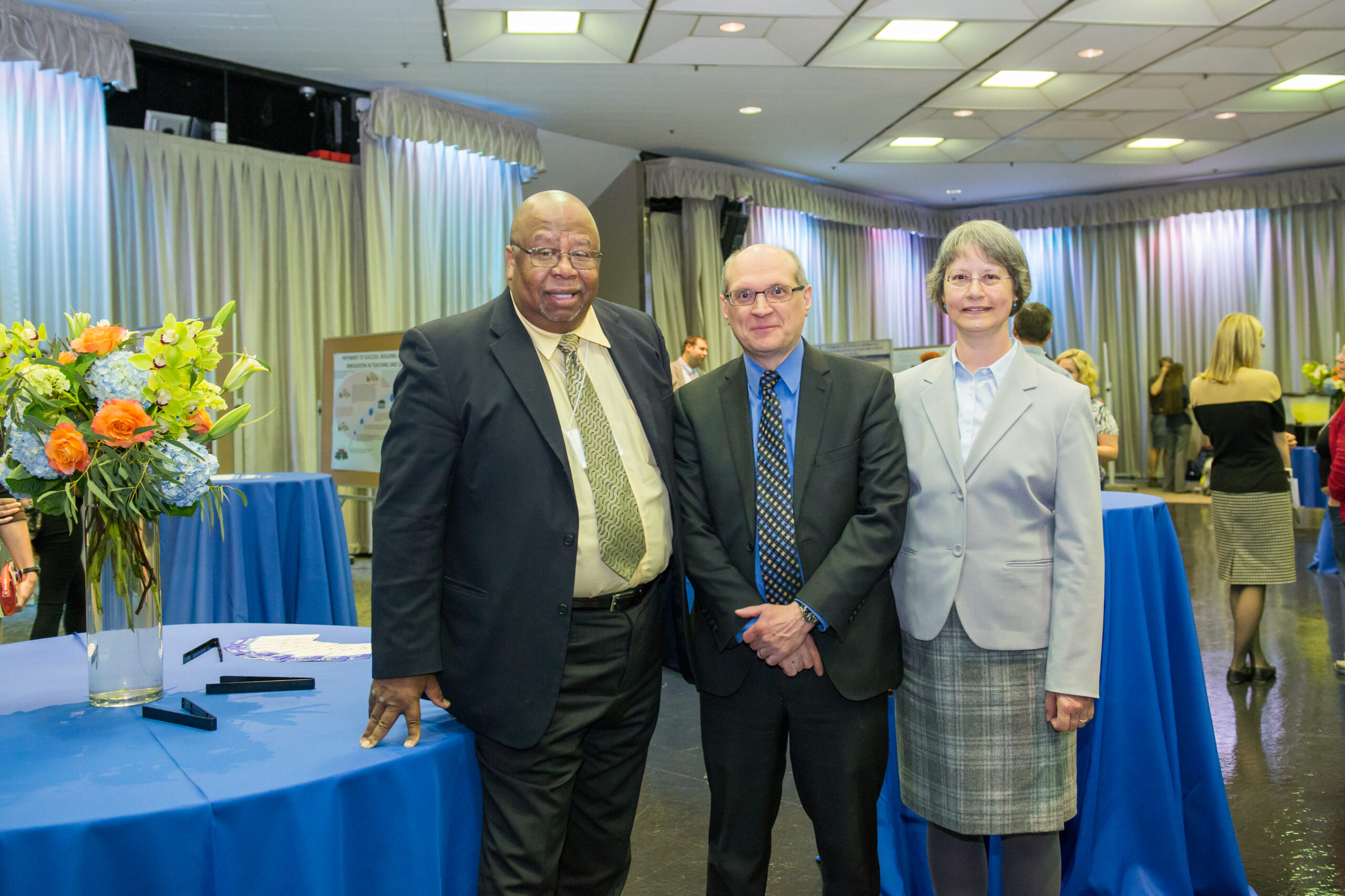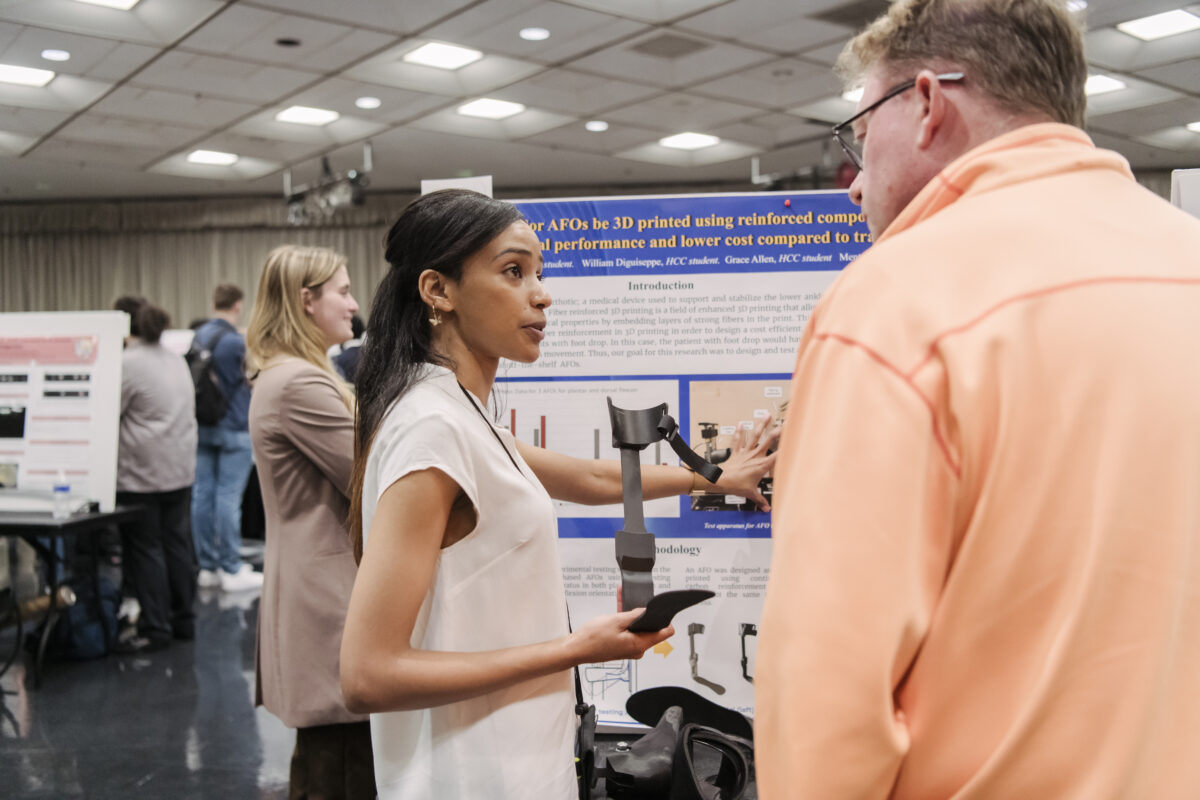UMBC faculty, students, alumni, and community partners gathered in the University Ballroom April 20, 2016 for “A Look Ahead XIX: Explorations in Transformative Research,” a day of research talks, presentations, and networking opportunities focusing on the life sciences and hosted by UMBC’s College of Natural and Mathematical Sciences (CNMS).
Dean Bill LaCourse opened the event by commenting on the dedication of UMBC partners and alumni, reflected in the two plenary speakers, saying, “This year’s ‘A Look Ahead’ shows the UMBC greatness we have today has its roots in greatness.”
“A Look Ahead” appealed to scientists at all stages of research. In his plenary, Isiah Warner, decorated analytical and environmental chemistry professor at the Louisiana State University and a UMBC parent, addressed the challenges of changing one’s research focus after developing a reputation in a particular field. As an investigator with an established lab and students relying on him, his decision to switch directions would ripple beyond himself, he realized. But ultimately, he said, “It was worth taking that leap of faith.”
Warner leaped from expertise in fluorescence spectroscopy, a technique that uses emitted light to analyze compounds, to ionic liquids. Ionic liquids are comprised of charged particles (ions) and are liquid at room temperature. The ions in ionic liquids don’t “pack nicely” together, instead flowing around each other, Warner said. However, ionic compounds that do pack well form solids at room temperature. Warner dubbed these “GUMBOS,” for “group of uniform materials based on organic salts,” as a nod to the dish popular in his Louisiana home.
GUMBOS are “tunable,” meaning scientists can change their properties with precision. And because they are solids, GUMBOS can be produced as nanoparticles, or “nanoGUMBOS.” Warner’s lab discovered one nanoGUMBO that killed cancer cells, but not healthy cells, in both petri dishes and mice. While nanoparticles have been developed for drug delivery before, the challenge has been getting the drug “loaded” into the particle. In this case, “The drug is the material,” said Warner. Besides its application to possible new cancer treatments, Warner’s team sees potential for applications in life sciences, solar cells, and engineering.
Taking the stage after Warner, Paula Grabowski ’76, chemistry, professor of biological sciences at the University of Pittsburgh, focused on her “journey through science,” including her time at UMBC and pioneering graduate work in Thomas Cech’s lab at the University of Colorado at Boulder.
Grabowski’s research has focused on RNA. For many years, RNA was believed to be nothing more than a transient, string-like molecule in the cell, delivering its message to build a protein and then rapidly breaking down. But “there’s so much more to [RNA],” Grabowski said. She was part of the project in Cech’s lab that discovered an essential role that RNA plays, that of enzyme catalyzing chemical reactions.
Grabowski’s passion for her work is palpable. “I was chomping at the bit to get onto that project,” she said.
Suggesting a radically different view of RNA to the scientific community came with its challenges. For a long time, even the lab didn’t believe what they were seeing. How could a simple RNA molecule be a catalyst? “[The result] smelled like an artefact,” Grabowski said. But after developing some new experimental techniques and running countless repeat trials, the evidence was overwhelming: RNA can serve as an enzyme.
Since Grabowski’s original discovery, RNA researchers have uncovered more surprises. For example, “RNA is a molecular contortionist,” explained Grabowski, describing the ways that it folds into remarkably complex three-dimensional structures—no longer just a simple string. Scientists now believe that RNA catalyzes a broader array of reactions, and they’ve developed techniques to create RNA molecules called “aptamers” that could have broad applications for disease treatment. This promising line of research “takes RNA from bench to bedside,” Grabowski said.
Grabowski also spoke of her time at UMBC as an undergraduate during the university’s first decade, recalling professors who “made chemistry come alive” and helped her realize she “wanted to have a passion.”
Reflecting on how UMBC has changed and remained the same over the decades, Grabowski shared that as a student, “UMBC faculty cared about my success as a student and my future,” and she sees that “UMBC is a treasure” today. Looking across at the audience of student researchers and successful alumni, she shared, “I couldn’t be more impressed with what has happened here.”
Image: Dr. Isiah Warner, Dean Bill LaCourse and Paula Grabowski ’76 at the A Look Ahead event. Photo by Marlayna Demond ’11 for UMBC.




